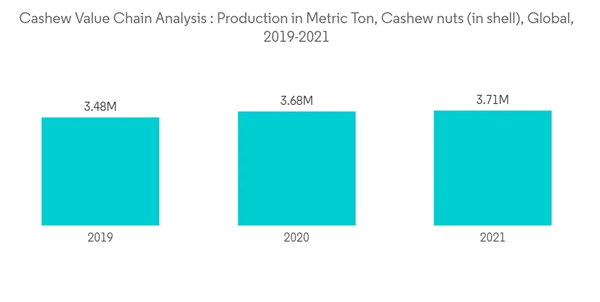Key Highlights
- Cashews are expensive because there is just one nut per fruit. Cashews trees must be farmed, harvested, separated from the false fruit, roasted, cooled, cracked open, peeled, sundried, and sorted - and only then can they be sold as raw nuts. The amount of value added is incommensurate with the amount of labor that goes into it. The Cashew Value chain comprises Individual growers and grower cooperatives, Collectors, Local traders, and Exporters.
- Individual growers and grower cooperatives are the stakeholders who produce cashew nuts. Local Middlemen, also known as Pisteurs, are the critical intermediary engaged in collecting raw cashew nuts from the farms and selling them to various buyers, including the buyers under contract, processing units, and traders. The local trader in the distribution of raw cashew nuts involves individual buyers and buyers under contract, who further sell the products to the processing units and the exporters for domestic consumption and exports, and the exporters of raw or processed cashew nuts consist of the export cooperatives and export companies. The export cooperatives purchase the raw cashew primarily from the grower cooperatives and occasionally from the individual growers to meet their export quota.
- Recently, there has been a growing inclination toward using cashew nuts in daily diets and healthy ready-to-eat snacks. The increasing number of cashew-infused product manufacturers has taken young and geriatric consumers by stride with the launch of innovative products, such as cashew-butter yogurt in the United States and roasted, spice-coated cashew nuts in India. Thus, over the long term, the high penetration rate of cashew-based retail manufacturers in the developed and emerging markets and the successful implementation of cashew production and processing initiatives in Africa are expected to drive the cashew market during the forecast period.
Cashew Market Trends
Increasing Government Initiatives to Boost Cashew Production
Cashew cultivation happens in a well-constructed stage in the respective value chain, with individual growers and grower cooperatives as the primary stakeholders. However, cashew cultivation is highly concentrated on individual farms, while an insignificant number of growers operate as part of cooperatives, which are relatively minor in size and area.Governments of Africa are reforming markets and revitalizing institutional infrastructure. For instance, "The African Cashew Initiative" has been helping to improve primary production, processing, and market linkages along the value chain of the cashew market. The project uses advisory services and training at all stages of the production process to help cashew farmers and processors in five African countries, namely Benin, Burkina Faso, Ivory Coast, Ghana, and Mozambique, to meet international standards. This project mainly focuses on supporting producers and processors to increase the yield and quality of their products and link the business players along the chain.
Furthermore, for increased cashew productivity, the Agricultural Science Institute for Southern Coastal Central of Vietnam (ASISOV) tested wide varieties of cashews, with trial production resulting in high productivity. These varieties were recognized by the Ministry of Agriculture and Rural Development (MARD) and put into mass production.
Further, in February 2022, to access the European, American, and Chinese markets, Vietnam undertook the EU-Vietnam Free Trade Agreement (EVFTA), UK-Vietnam FTA (EVFTA), and Comprehensive and Progressive Agreement for Trans-Pacific Partnership (CPTPP). Therefore, these government initiatives boost the country's cashew production.
Asia-Pacific is Leading the Consumer Demand
Asia-Pacific has been a consistent importer of cashew kernels despite the presence of large cashew-producing countries, such as India and Vietnam, in the region. In terms of consumption, India is the leading country in the world. As Vietnam leads in the production of cashews worldwide, it is also a significant exporter of the same to other international markets.Asia-Pacific is the largest consumer of cashew nuts in the world. In recent years, there has been an increasing interest in the use of cashew nuts in regular diets and healthy ready-to-eat snacks. The rising number of manufacturers producing innovative cashew-based consumables has taken both the young and geriatric consumers by stride; for example, roasted and spice-coated cashew nuts, that appeal to the local palate, were introduced in India.
Nuts have become a primary component in the Chinese diet since the inception of the National Health Policy called 'Dietary Guidelines for Chinese Residents', which emphasizes daily nut consumption. The increased cashew nut imports may also be attributed to the new product campaign of selling 'daily nuts', including cashews, in ready-to-eat packages, by Chinese nut manufacturers, thus driving the cashew nut market in the country.
Additional Benefits:
- The market estimate (ME) sheet in Excel format
- 3 months of analyst support
This product will be delivered within 2 business days.










